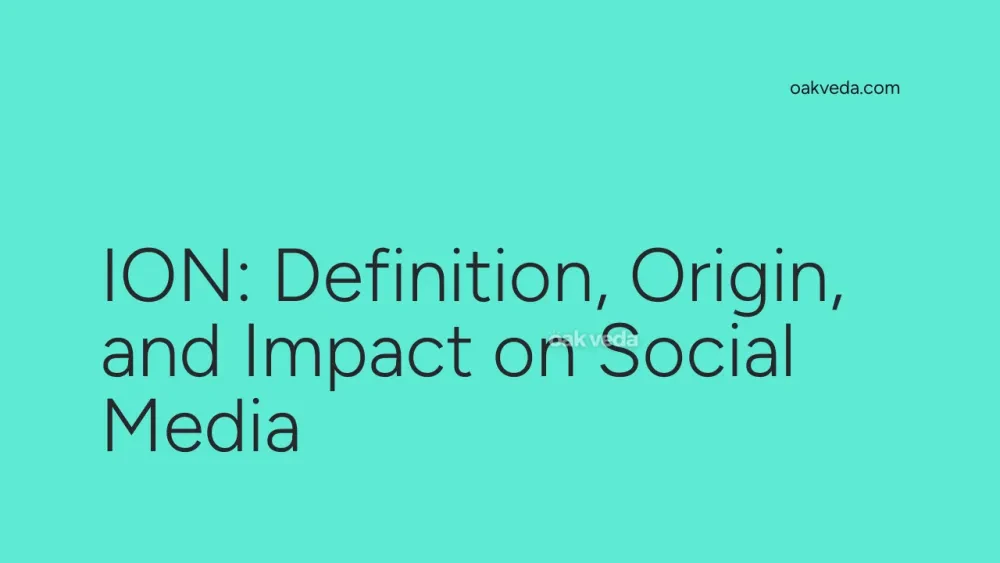
What is ION?
ION is an acronym that stands for "In Other News" in social media and online communication. This popular shorthand is used to introduce a new topic or shift the focus of a conversation, especially in informal digital interactions. ION serves as a bridge between unrelated subjects, allowing users to smoothly transition to different talking points without abruptly changing the flow of conversation.
Origin and Development of ION
The exact origin of ION is difficult to pinpoint, as it emerged organically with the rise of text-based communication platforms. As internet users sought ways to communicate more efficiently, acronyms like ION became increasingly common. The term gained popularity in the early 2000s with the growth of instant messaging services and online forums, and its usage has since expanded across various social media platforms.
How ION Works
ION functions as a conversational tool in digital communication. Here's how it typically works:
- A user is engaged in a conversation about a particular topic.
- They want to introduce a new, unrelated subject.
- The user types "ION" followed by the new information or topic.
- This signals to other participants that a topic shift is occurring.
For example:
User 1: "Just finished my exams. So relieved!" User 2: "Congrats! How do you think you did?" User 1: "Pretty well, I hope. ION, did you hear about the new coffee shop opening downtown?"
In this exchange, ION allows for a smooth transition to a completely different subject.
Popular Examples of ION Usage
ION is widely used across various social media platforms and messaging apps. Some common examples include:
- Twitter: Users often use ION to share unrelated news or thoughts within a thread.
- Instagram: In comments or direct messages, ION helps introduce new topics.
- Facebook: In status updates or comments, ION can signal a shift in conversation.
- WhatsApp: Group chats often see ION used to bring up new subjects.
Impact of ION on Social Media Culture
The widespread adoption of ION has significantly influenced online communication patterns:
-
Conversation Fluidity: ION enables more dynamic and multi-topic conversations, reflecting the fast-paced nature of digital interaction.
-
Informal Communication: Its usage contributes to the casual tone prevalent in social media exchanges.
-
Information Sharing: ION facilitates the quick dissemination of diverse information within a single conversation thread.
-
Attention Management: It helps users navigate the constant influx of information on social platforms by clearly demarcating topic changes.
How Brands and Influencers Use ION
Savvy brands and influencers have incorporated ION into their social media strategies:
- Content Variety: They use ION to introduce diverse content without creating separate posts, maintaining audience engagement.
- Casual Branding: Employing ION helps brands appear more relatable and in tune with social media language.
- Newsjacking: Influencers often use ION to seamlessly introduce trending topics or news items into their content.
- Audience Interaction: It's used to respond to comments or questions while also sharing additional information.
Future Trends Related to ION
As social media continues to evolve, we can expect to see:
-
Integration into AI: Chatbots and AI assistants may incorporate ION to mimic human conversation patterns more accurately.
-
Visual Representations: Platforms might introduce visual cues or emojis to represent ION, enhancing its visibility in text-heavy environments.
-
Cross-Platform Usage: As users navigate multiple social media platforms simultaneously, ION could become a universal signal for topic transitions.
-
Language Evolution: ION might inspire new, related acronyms or shorthand expressions for different types of topic shifts.
FAQs about ION
1. Is ION appropriate for professional communication?
While ION is primarily used in informal settings, it can be appropriate in casual professional environments where team members communicate via chat apps. However, it's best to avoid it in formal business communications or with clients.
2. Can ION be used at the beginning of a conversation?
Typically, ION is used to transition between topics in an ongoing conversation. Using it at the start of an interaction might seem abrupt. However, in some contexts, like group chats with continuous conversations, it could be acceptable.
3. Are there any alternatives to ION?
Yes, some alternatives include:
- "BTW" (By The Way)
- "On another note"
- "Changing gears"
- "Speaking of which"
4. How do I know when it's appropriate to use ION?
ION is best used in casual, friendly conversations where a sudden topic change won't be perceived as rude. It's particularly useful in fast-paced digital environments where multiple subjects might be discussed simultaneously.
5. Does ION have different meanings in different contexts?
While ION primarily means "In Other News" in social media contexts, it's worth noting that in other fields, ION can have different meanings. For example, in science, it refers to an atom or molecule with a net electric charge. Always consider the context to ensure clear communication.
In conclusion, ION has become an integral part of social media language, facilitating dynamic conversations and information sharing. As digital communication continues to evolve, understanding and effectively using acronyms like ION can enhance one's ability to navigate and engage in online social interactions.
You may be interested in:
- Fax No Printer: Definition, Origin, and Impact
- Repin: Definition, Origin, and Impact on Pinterest
- Ded: Definition, Origin, and Impact on Social Media
- Instagram Algorithm: Definition, Origin, and Impact
- Link in Bio: Definition, Origin, and Impact on Social Media
- Touch Grass: Definition, Origin, and Impact on Social Media

